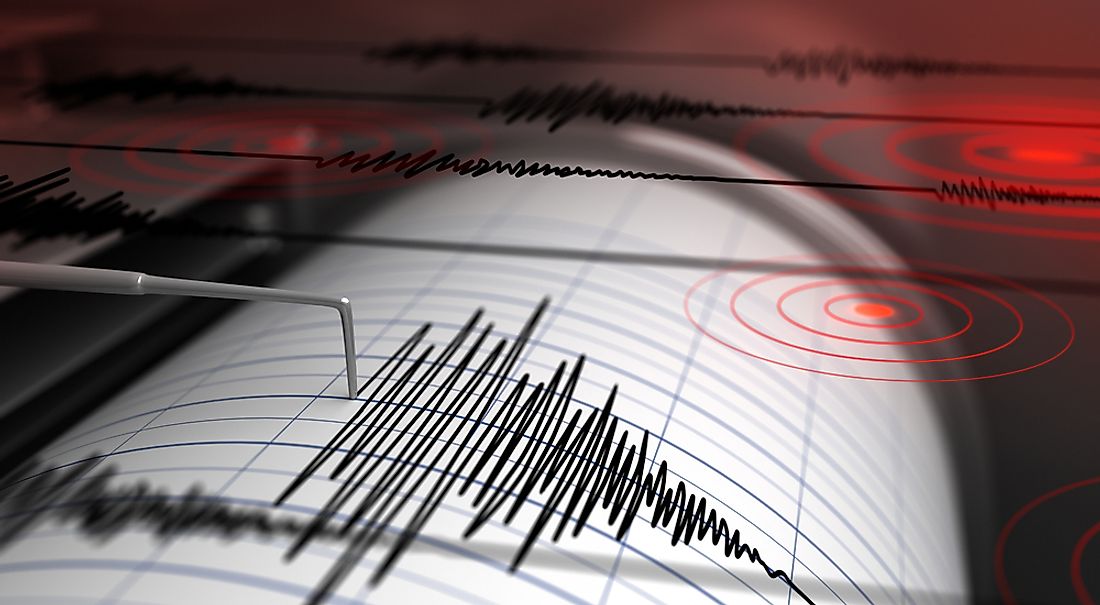Where Do You Get Earthquake in Fire Red
The World's 10 Most Earthquake Prone Countries

Earthquakes are one of the most devastating of all natural disasters. Earthquakes are very difficult to predict as events that lead to these disasters happen deep down in the earth. Tectonic plate movements are the primary cause of earthquakes. Volcanic eruptions can also trigger earthquakes but are often, in turn, caused by tectonic activity.
Not every country in the world is susceptible to earthquakes. The world's most earthquake-prone countries include China, Indonesia, Iran, and Turkey.
1. China
China experienced 157 earthquakes from 1900 to 2016, the highest number of earthquakes of any country. Most of these earthquakes happened in the southwest region of the country, where the terrain is highly mountainous. Luckily for China, some of the least populous provinces, namely Sichuan, Gansu, Qinghai, Xinjiang, Tibet, and Yunnan, are located in this region. The rugged terrain and harsh climate of this region are not conducive to support high populations. However, due to the poor transportation infrastructure and remote mountainous topography of the southwest, rescue and recovery after an earthquake become an extremely challenging task.
2. Indonesia
With 113 earthquakes of significant magnitude between 1900 and 2016, Indonesia ranks as the world's second most earthquake-prone country. The primary reason for the high frequency of earthquakes in Indonesia is its location on the Ring of Fire. The majority of the world's earthquakes happen in the Ring of Fire, which encompasses a shoe-shaped area of about 40,000 square km. The movement of tectonic plates in the area, as well as submarine or surface volcanic eruptions, have triggered many earthquakes that have affected Indonesia over the centuries.
3. Iran
Iran, a country in the Middle East, is located in an area of high seismic activity. It is the third most earthquake country in the world and has experienced at least 106 earthquakes from 1900 to 2016. The country exists where the Eurasian and Arabian tectonic plates meet. The Zagros Mountains, one of the world's youngest mountain range, developed in the area due to the subduction of the Arabian place under the Iranian plate, the latter being a part of the larger Eurasian plate. Due to the location of Iran at a collision zone of the different plates, earthquakes in the country are inevitable. What is more, the seismic zone encompasses most of the country with an area that is 1600 kilometers long and 400 kilometers wide. Instead of a single sharp plate boundary, Iran has numerous fracture zones that makes it more susceptible to catastrophic earthquakes.
4. Turkey
Like other countries in the list, Turkey also sits atop one of the world's most seismically active spots, the plate boundary between the Eurasian and Arabian plates. The Arabian plate is inching northwards towards the relatively stable Eurasian Plate. Turkey is located at the boundary of impact between these plates. The movement of the Arabian Plate, in turn, is triggered by the formation and spread of new crust along the mid-sea ridges of the Red Sea and the Gulf of Aden. The spreading of this new crust provides the northward push to the Arabian plate. The pressure from the Arabian plate has already generated two faults in the country that start from a common point and then part ways as the Northern Anatolian Fault and the Eastern Anatolian Fault. Locations along these faults are highly susceptible to earthquakes.
5. Japan
Like Indonesia, Japan is near the Pacific Ring of Fire which makes it highly vulnerable to catastrophic earthquakes. The movement and collisions of the continental and oceanic plates in and around Japan are responsible for these disasters. Japan is on the joint of four different tectonic plates. These are the North America plate, Pacific plate, Philippine plate, and the Eurasian plate. The movement and subduction of the Philippine and Pacific plates under the two other plates cause earthquakes.
6. Peru
Peru is at the interface between the South American and Nazca plates. The movement of the former over the latter at a rate of 77 mm per year is triggering the earthquakes due to thrust faulting at the plate interface. Volcanism in the highlands of Peru and the formation of the Peru–Chile Trench and the Andes Mountains are also a result of plate tectonics due to the movement of these plates.
7. United States
Parts of the west coast of the United States are in the Pacific Ring of Fire. Plate tectonics is also active in the region. The dynamic boundary of the Pacific and North American plates is responsible for many earthquakes in the country, especially in Alaska and California. In the latter, the San Andreas Fault runs a long distance making the state highly prone to disasters.
8. Italy
In Italy, the southern part of the country is most susceptible to earthquakes as the Eurasian and African plates collide in this region. Most of Italy's most dangerous volcanoes like Etna, Vesuvius, and Stromboli are in this region.
Other Countries That Are Highly Prone To Earthquakes
Afghanistan and India are also highly prone to earthquakes due to the action of plate tectonics. The Indian plate is constantly moving northwards and ramming into the Eurasian plate, which is the main cause of earthquakes in the Indian subcontinent. Greece and Mexico are also vulnerable to earthquake events.
The World's 10 Most Earthquake Prone Countries
| Rank | Country | Number of earthquakes, 1900 to 2016 |
|---|---|---|
| 1 | China | 157 |
| 2 | Indonesia | 113 |
| 3 | Iran | 106 |
| 4 | Turkey | 77 |
| 5 | Japan | 61 |
| 6 | Peru | 44 |
| 7 | United States of America | 41 |
| 8 | Italy | 33 |
| 9 | Afghanistan, India, Greece, and Mexico | 32 |
- Home
- World Facts
- The World's 10 Most Earthquake Prone Countries
Where Do You Get Earthquake in Fire Red
Source: https://www.worldatlas.com/articles/the-world-s-10-most-earthquake-prone-countries.html